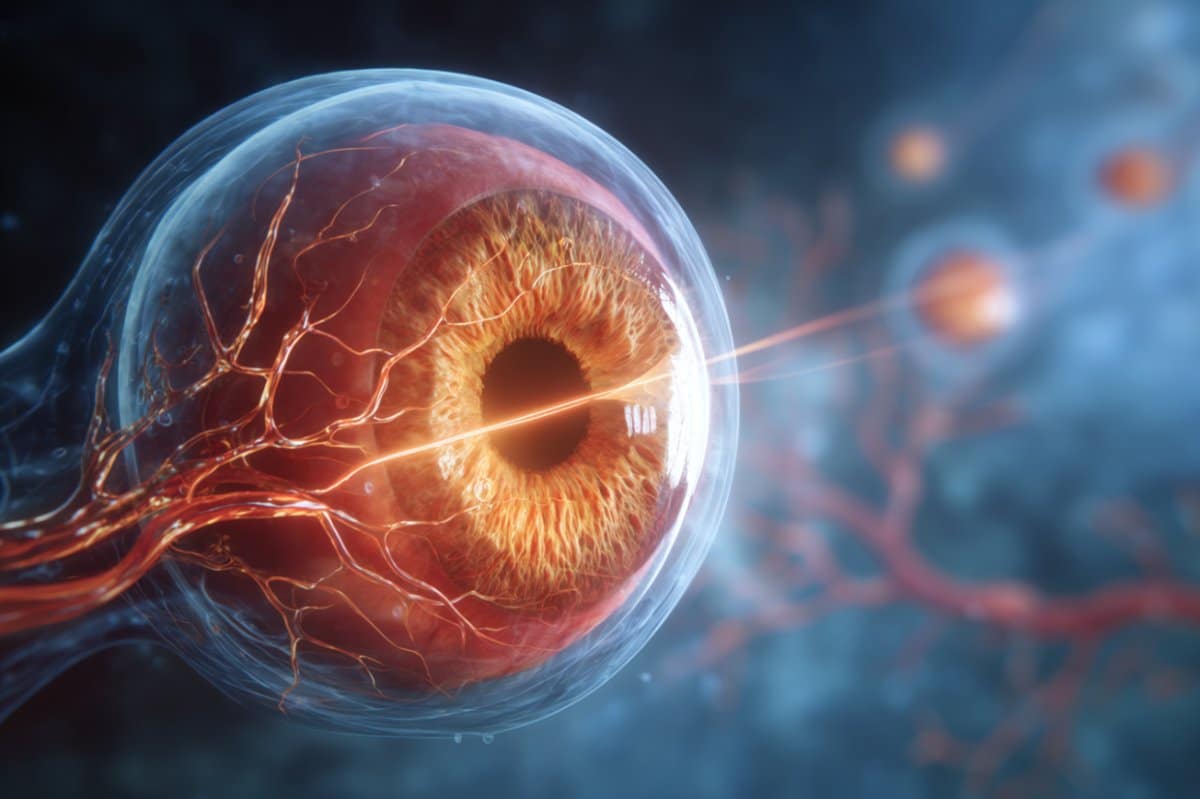Summary: Eye exams could help detect Alzheimer’s disease years before symptoms arise. By studying mice with a common genetic mutation, researchers found abnormal changes in retinal blood vessels that paralleled brain changes linked to dementia risk.
Because the retina functions as an accessible extension of the brain, these findings highlight its potential as a powerful biomarker. The research paves the way for routine eye exams to aid in early diagnosis and intervention for Alzheimer’s and related conditions.
Key Facts
- Retina as Brain Window: The retina shares tissue with the brain, making it a reliable site to track neurological health.
- Genetic Risk Factor: Mice with the MTHFR677C>T mutation showed early retinal vessel abnormalities tied to dementia.
- Clinical Potential: Routine eye exams could one day detect Alzheimer’s risk 20 years before symptoms appear.
Source: Jackson Laboratory
Within the next few years, doctors may be able to spot signs of Alzheimer’s disease and other dementias using routine eye exams well before symptoms appear, a new study suggests.
The research, recently published in Alzheimer’s & Dementia, links abnormal changes in the tiny blood vessels of the retinas of mice with a common genetic mutation known to increase Alzheimer’s disease risk.

The findings build on previous work from the same group at The Jackson Laboratory (JAX), which found similar vascular changes in mice’s brains and linked abnormalities in specific retinal cells to early dementia risk, strengthening the case that the retina is a powerful biomarker for Alzheimer’s disease and other dementias.
“If you’re at an optometrist or ophthalmologist appointment, and they can see odd vascular changes in your retina, that could potentially represent something that is also happening in your brain, which could be very informative for early diagnostics,” said Alaina Reagan, a neuroscientist at The Jackson Laboratory (JAX) who led the work with Gareth Howell, professor and Diana Davis Spencer Foundation Chair for Glaucoma Research at JAX who spearheaded the previous study.
Because the retina is part of the central nervous system, scientists often see it as an extension of the brain that shares essentially the same tissue. That’s why changes in retinal blood vessels can offer early clues about brain health and diseases like Alzheimer’s, Reagan said.
“Your retina is essentially your brain, but it’s much more accessible because your pupil is just a hole, and we can see tons of stuff,” Reagan explained.
“All the cells are very similar, all the neurons are quite similar, all the immune cells are quite similar, and they behave similarly under pressure if you’ve got a disease.”
The team studied mice with a mutation called MTHFR677C>T, which is found in up to 40% of people. They found that the mice’s retinas had twisted vessels, narrowed and swollen arteries, and less vessel branching as early as six months of age.
This reflects similar changes in the brain linked to poor blood flow and increased risk of cognitive decline. Vessels that appear more twisted and looped than normal can signal problems with hypertension, as the narrowing tissue limits nutrient and oxygen transport, Reagan said.
“We can see these wavy vessels in the retinas, which can occur in people with dementia,” Reagan said. “That speaks to a more systemic problem, not just a brain- or retina-specific problem. It could be a blood pressure problem affecting everything.”
In 2022, a study by the same group revealed similar vascular changes in the brains of mice with the same MTHFR677C>T mutation, highlighting the link between vascular health in the retina that resembles human disease.
“These mice have fewer vessels in their cortex and reduced blood flow to their brains,” Reagan said. “These changes are subtle, but they are there.”
The team also discovered changes in protein patterns in both the brain and retina. They found disruptions in how cells produce energy, remove damaged proteins, and maintain the structure and support of blood vessels, offering important clues about how the MTHFR677C>T mutation affects the eye.
The results also support a growing theory that blood vessel health plays a central role in neurodegenerative diseases, Reagan said.
“A lot of these molecular changes are happening in conjunction, which suggests these systems in brain and retinal tissue are working in tandem,” she said.
Even though more studies are needed to gain a deeper understanding of how vascular health in the retina affects the risk of dementia, the new insights have important implications for people with this genetic factor, Reagan said.
For example, the study also captured the influence of sex and age, with female mice showing worse outcomes. By 12 months, they showed reduced vessel density and branching, highlighting progressive vascular changes. Similarly, women develop dementia more often than men, according to the World Health Organization.
To see if the link between the mutation and vascular changes occurs in humans, as well as whether the new insight could be used in eye exams, the team is partnering with clinicians and dementia care specialists at Northern Light Acadia Hospital in Bangor, Maine.
The idea is to study not just one cause or solution for Alzheimer’s and other dementias, as these conditions depend on many different genetic and environmental factors, but to learn more about how eye health adds to overall risk for these diseases. If the clinicians know which signs to look for, they could communicate those risk factors to patients and recommend further tests.
“Most people over 50 have some kind of vision impairment and get checked annually for prescription changes,” Reagan said.
“Are they more at risk if they have these vascular changes, and is that a point when doctors could start mitigating brain changes? That could be 20 years before cognitive damage becomes noticeable to patients and their families.”
Other authors are Michael MacLean, Travis L. Cossette, and Gareth R. Howell from The Jackson Laboratory.
About this visual neuroscience and Alzheimer’s disease research news
Author: Roberto Molar
Source: Jackson Laboratory
Contact: Roberto Molar – Jackson Laboratory
Image: The image is credited to Neuroscience News
Original Research: Open access.
“Retinal vascular dysfunction in the Mthfr677C>T mouse model of cerebrovascular disease” by Alaina Reagan et al. Alzheimer’s & Dementia
Abstract
Retinal vascular dysfunction in the Mthfr677C>T mouse model of cerebrovascular disease
INTRODUCTION
Investigations of retinal biomarkers for Alzheimer’s disease (AD) and AD and related dementias (ADRD), has increased significantly. We examine retinal vascular health in a mouse containing the ADRD risk variant Mthfr677C>T to determine if changes in retina mirror similar changes in cerebrovasculature.
METHODS
Morphology and function of retinal vasculature and neurons were assessed using in vivo imaging, immunohistochemistry, and pattern electroretinography. RNAscope and proteomics were employed to determine Mthfr gene expression and differential protein expression in mice carrying Mthfr677C>T.
RESULTS
Mice show age- and sex-dependent retinal vascular deficits, displaying similarities to previously published brain data. Mthfr is widely expressed and co-localizes with vascular cell markers. Proteomics identified common molecular signatures across the brain and retina.
DISCUSSION
Results demonstrate that Mthfr-dependent vascular phenotypes occur in brain and retina similarly. These data suggest that assessing age and genetic-driven changes within retinal vasculature represents a minimally invasive method to predict AD-related cerebrovascular damage.






